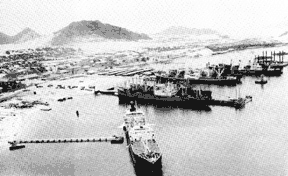The U.S. Merchant Marine Academy (USMMA), established in 1943, is operated by the Maritime Administration of the U.S. Department of Transportation. The mission of the Academy, located on 82-waterfront acres 20 miles from New York City, is to educate and graduate officers and leaders of honor and integrity to serve in America's merchant marine, maritime and intermodal transportation industries, and the Armed Forces.
Click for the rest of the story


US MERCHANT MARINE IN VIETNAM
Army In February 1951 the Military Sea Transportation Service (MSTS) aircraft carrier Windham Bay, was the first large ship to navigate the Long Tam River since 1925. While the ship was docked at Saigon (French Indochina) 17 hand grenades were tossed at the ship by terrorists.
The Military Sea Transportation Service was established in 1949 to provide sea transportation to the military as a successor to the Army Transportation Service. MSTS operated a fleet of ships and had charter agreements with commercial shipping firms. MSTS was succeeded by Military Sealift Command.
In 1954, after the partitioning of Vietnam, MSTS evacuated Vietnamese refugees from North to South Vietnam. USNS Howze was one of many MSTS ships involved in "Passage to Freedom" bringing 300,000 refugees and 200,000 tons of Cargo from North Vietnam. [Your webmistress arrived in the United States in 1949 on the USAT General R. L. Howze as a refugee of World War II.]
The Military Sea Transportation Service had the job of bringing war supplies to Vietnam -- 10,000 miles from the Pacific coast. MSTS had four separate customers to serve: the Army, Air Force, Navy and Marine Corps. MSTS ships were staffed by "civilian" crews, but carried 95% of the supplies used by our Armed Forces in Vietnam including bombs and ammunition into combat zones under fire. Crew members were given Navy grades and rank identification in event of enemy capture. During Vietnam, MSTS first utilized roll-on/roll-off ships and container ships which speeded loading and unloading.
Click for the rest of the story

United States Army
United States Navy
United States Marine Corps
United States Air Force
United States Coast Guard


US MERCHANT MARINE IN WORLD WAR II
One way to understand the Second World War is to appreciate the critical role of merchant shipping... the availability or non-availability of merchant shipping determined what the Allies could or could not do militarily.... when sinkings of Allied merchant vessels exceeded production, when slow turnarounds, convoy delays, roundabout routing, and long voyages taxed transport severely, or when the cross-Channel invasion planned for 1942 had to be postponed for many months for reasons which included insufficient shipping.
Had these ships not been produced, the war would have been in all likelihood prolonged many months, if not years. Some argue the Allies would have lost as there would not have existed the means to carry the personnel, supplies, and equipment needed by the combined Allies to defeat the Axis powers. [It took 7 to 15 tons of supplies to support one soldier for one year.] The U.S. wartime merchant fleet. . . constituted one of the most significant contributions made by any nation to the eventual winning of the Second World War.
In the final assessment, the huge US merchant fleet... provided critical logistical support to the war effort.
\Click for the rest of the story

